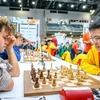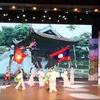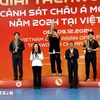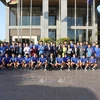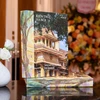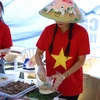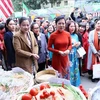 On the occasion of 75 years since the launch of the National Resistance War (December 19, 1946 - 2021), the Vietnam National Museum of History and the Archives Department of the Party Central Committee’s Office on December 16 opened an exhibition about Viet Bac, a region located in the north of Hanoi that served as the base of support during the resistance war against the French colonialists (1946 - 1954). The event features more than 200 outstanding documents, objects, and images recalling the historic moments of the country. Before that, ‘Khu giai phong Viet Bac’ (Viet Bac Liberation Zone) was set up in June 1945 to prepare for the August Revolution to seize power and gain independence. (Photo: VietnamPlus)
On the occasion of 75 years since the launch of the National Resistance War (December 19, 1946 - 2021), the Vietnam National Museum of History and the Archives Department of the Party Central Committee’s Office on December 16 opened an exhibition about Viet Bac, a region located in the north of Hanoi that served as the base of support during the resistance war against the French colonialists (1946 - 1954). The event features more than 200 outstanding documents, objects, and images recalling the historic moments of the country. Before that, ‘Khu giai phong Viet Bac’ (Viet Bac Liberation Zone) was set up in June 1945 to prepare for the August Revolution to seize power and gain independence. (Photo: VietnamPlus)  Following the success of the August Revolution in 1945, which led to the establishment of the Democratic Republic of Vietnam (now the Socialist Republic of Vietnam) on September 2 the same year, the country strived to make détente and concessions in efforts to secure peace but was still unable to change France’s ambition to restore their colonial presence in Vietnam. To safeguard the newly gained independence, the Vietnamese Government and people resigned themselves to launch a resistance war against the French colonialists nationwide. On behalf of the Party Central Committee, then President Ho Chi Minh wrote and issued an appeal for a national resistance war on December 19, 1946, calling on the entire people to rise up against the invaders to defend the national independence. (Photo: VietnamPlus)
Following the success of the August Revolution in 1945, which led to the establishment of the Democratic Republic of Vietnam (now the Socialist Republic of Vietnam) on September 2 the same year, the country strived to make détente and concessions in efforts to secure peace but was still unable to change France’s ambition to restore their colonial presence in Vietnam. To safeguard the newly gained independence, the Vietnamese Government and people resigned themselves to launch a resistance war against the French colonialists nationwide. On behalf of the Party Central Committee, then President Ho Chi Minh wrote and issued an appeal for a national resistance war on December 19, 1946, calling on the entire people to rise up against the invaders to defend the national independence. (Photo: VietnamPlus)  The initial part of the exhibition provides an introduction of the achievements of the August Revolution, which resulted in the foundation of the Democratic Republic of Vietnam in September 1945. The others give visitors a closer look at the resistance war that was full of difficulties, hardships, and sacrifice. When it was set up in June 1945, the Viet Bac Liberation Zone covered the liberated areas of six northern mountainous provinces, namely Cao Bang, Bac Kan, Lang Son, Ha Giang, Tuyen Quang, and Thai Nguye, along with part of Bac Giang, Phu Tho, Yen Bai, and Vinh Phuc provinces, becoming the revolutionary base of the entire country. (Photo: VietnamPlus)
The initial part of the exhibition provides an introduction of the achievements of the August Revolution, which resulted in the foundation of the Democratic Republic of Vietnam in September 1945. The others give visitors a closer look at the resistance war that was full of difficulties, hardships, and sacrifice. When it was set up in June 1945, the Viet Bac Liberation Zone covered the liberated areas of six northern mountainous provinces, namely Cao Bang, Bac Kan, Lang Son, Ha Giang, Tuyen Quang, and Thai Nguye, along with part of Bac Giang, Phu Tho, Yen Bai, and Vinh Phuc provinces, becoming the revolutionary base of the entire country. (Photo: VietnamPlus)  The display helps underline the significance of the Day of the National Resistance War (December 19, 1946) and the Viet Bac revolutionary base. It is also meant to affirm the sound and clear-sighted leadership by the Party and President Ho Chi Minh, as well as contributions by people from all social strata to the struggle to defend the national independence and freedom. In early 1947, facing France’s steps to reoccupy the country, President Ho Chi Minh and the Government moved to Viet Bac to lead the resistance war. Since then, Viet Bac became the base of support for the war until October 10, 1954, when Hanoi was liberated and the revolutionary government left Viet Bac to take over the capital from France. (Photo: VietnamPlus)
The display helps underline the significance of the Day of the National Resistance War (December 19, 1946) and the Viet Bac revolutionary base. It is also meant to affirm the sound and clear-sighted leadership by the Party and President Ho Chi Minh, as well as contributions by people from all social strata to the struggle to defend the national independence and freedom. In early 1947, facing France’s steps to reoccupy the country, President Ho Chi Minh and the Government moved to Viet Bac to lead the resistance war. Since then, Viet Bac became the base of support for the war until October 10, 1954, when Hanoi was liberated and the revolutionary government left Viet Bac to take over the capital from France. (Photo: VietnamPlus)  Addressing the opening ceremony of the exhibition, Director of the Vietnam National Museum Nguyen Van Doan said that the exhibition reminds people of the brave fight against the French colonists to gain independence and enhance people’s belief in the guidelines of the Party and President Ho Chi Minh as well as encourage people to unite to overcome all challenges in the renewal process and successfully implement the Resolution of the 13th National Party Congress. The resolution, adopted on February 1, underlines the overall goals and concrete targets for 2025, 2030, and 2045; and identified major socio-economic development targets for 2021- 2025, orientations for national development for 2021 - 2030, and the six key tasks for the 13th tenure. (Photo: VietnamPlus)
Addressing the opening ceremony of the exhibition, Director of the Vietnam National Museum Nguyen Van Doan said that the exhibition reminds people of the brave fight against the French colonists to gain independence and enhance people’s belief in the guidelines of the Party and President Ho Chi Minh as well as encourage people to unite to overcome all challenges in the renewal process and successfully implement the Resolution of the 13th National Party Congress. The resolution, adopted on February 1, underlines the overall goals and concrete targets for 2025, 2030, and 2045; and identified major socio-economic development targets for 2021- 2025, orientations for national development for 2021 - 2030, and the six key tasks for the 13th tenure. (Photo: VietnamPlus)  A pistol used by soldiers of the Capital Regiment in Hanoi during the early days of the National Resistance War in December 1946. On the night of December 19, 1946, in response to the 'Call for National Resistance' of then President Ho Chi Minh, the army and people of Hanoi capital city stood up with the spirit of fighting to the death for the nation, resulting in 60 fierce days and nights of the resistance war. Following nine years of the long-term resistance war, the triumphant Vietnamese army marched in Hanoi to take over the capital city from the colonial French rulers. (Photo: VietnamPlus)
A pistol used by soldiers of the Capital Regiment in Hanoi during the early days of the National Resistance War in December 1946. On the night of December 19, 1946, in response to the 'Call for National Resistance' of then President Ho Chi Minh, the army and people of Hanoi capital city stood up with the spirit of fighting to the death for the nation, resulting in 60 fierce days and nights of the resistance war. Following nine years of the long-term resistance war, the triumphant Vietnamese army marched in Hanoi to take over the capital city from the colonial French rulers. (Photo: VietnamPlus)  Visitors to the exhibition. The thematic exhibition 'Viet Bac - the Capital of Forest Wind' is being held by the Vietnam National Museum of History and the Archives of the Office of the Party Central Committee on the occasion of the 75th anniversary of the National Resistance Day (December 19, 1946 - 2021). The exhibition showcases nearly 200 documents, objects and photos. The objects conveyed the message of the nation’s aspiration for peace and independence, thereby affirming the leadership role of the Party and President Ho Chi Minh as well as the contributions of people to the resistance war against the French colonialists (1946 -1954). (Photo: VietnamPlus)
Visitors to the exhibition. The thematic exhibition 'Viet Bac - the Capital of Forest Wind' is being held by the Vietnam National Museum of History and the Archives of the Office of the Party Central Committee on the occasion of the 75th anniversary of the National Resistance Day (December 19, 1946 - 2021). The exhibition showcases nearly 200 documents, objects and photos. The objects conveyed the message of the nation’s aspiration for peace and independence, thereby affirming the leadership role of the Party and President Ho Chi Minh as well as the contributions of people to the resistance war against the French colonialists (1946 -1954). (Photo: VietnamPlus)  Musical instruments used during the resistance war against the French colonialists. The resistance war started on December 19, 1946 in Hanoi and some other localities, then spread nationwide. One day later on December 20, President Ho Chi Minh, on behalf of the Democratic Republic of Vietnam Government, called upon the entire population to take part in the resistance war, having affirmed the Vietnamese nation's iron will not to lose the country and not to be enslaved again. The great victory of the Vietnamese people's resistance war against the French colonialists in 1954 led to the signing of the agreement on ceasefire in Indochina. (Photo: VietnamPlus)
Musical instruments used during the resistance war against the French colonialists. The resistance war started on December 19, 1946 in Hanoi and some other localities, then spread nationwide. One day later on December 20, President Ho Chi Minh, on behalf of the Democratic Republic of Vietnam Government, called upon the entire population to take part in the resistance war, having affirmed the Vietnamese nation's iron will not to lose the country and not to be enslaved again. The great victory of the Vietnamese people's resistance war against the French colonialists in 1954 led to the signing of the agreement on ceasefire in Indochina. (Photo: VietnamPlus)  A woman looks at an exhibit at the exhibition. The display is a general picture that helps deepen the position, stature and historical value of the Day of the National Resistance War and the Viet Bac Revolutionary Base, and offers a chance for the public to recall the heroic and glorious resistance years of the Vietnamese army and people in the resistance war against the French colonialists. It aims to celebrate the Day of the National Resistance War on December 19, 1946, when then President Ho Chi Minh launched his call on all people to join in the war against French colonists. The Viet Bac Revolutionary Base in northern Thai Nguyen province hosted President Ho Chi Minh and his comrades to stay and lead the revolution. (Photo: VietnamPlus)
A woman looks at an exhibit at the exhibition. The display is a general picture that helps deepen the position, stature and historical value of the Day of the National Resistance War and the Viet Bac Revolutionary Base, and offers a chance for the public to recall the heroic and glorious resistance years of the Vietnamese army and people in the resistance war against the French colonialists. It aims to celebrate the Day of the National Resistance War on December 19, 1946, when then President Ho Chi Minh launched his call on all people to join in the war against French colonists. The Viet Bac Revolutionary Base in northern Thai Nguyen province hosted President Ho Chi Minh and his comrades to stay and lead the revolution. (Photo: VietnamPlus)  A Capital Regiment badge in 1946 - 1947. Over nine years, the Viet Bac Revolutionary Base in the northern province of Thai Nguyen, which was known as the Safe Zone or Forest Wind Capital, hosted various important events, playing a decisive role in the final victory of the revolution. At the base, President Ho Chi Minh, the Party Central Committee and Government gathered and led Viet Bac Fighting in Autumn - Winter of 1947, the Northern Border Victory in 1950, the second National Party Congress in Chiem Hoa, Tuyen Quang, victories in Winter - Spring of 1953 - 1954 with the Dien Bien Phu Victory on May 7, 1954 as the peak. (Photo: VietnamPlus)
A Capital Regiment badge in 1946 - 1947. Over nine years, the Viet Bac Revolutionary Base in the northern province of Thai Nguyen, which was known as the Safe Zone or Forest Wind Capital, hosted various important events, playing a decisive role in the final victory of the revolution. At the base, President Ho Chi Minh, the Party Central Committee and Government gathered and led Viet Bac Fighting in Autumn - Winter of 1947, the Northern Border Victory in 1950, the second National Party Congress in Chiem Hoa, Tuyen Quang, victories in Winter - Spring of 1953 - 1954 with the Dien Bien Phu Victory on May 7, 1954 as the peak. (Photo: VietnamPlus)  A shirt with blood stain of soldiers of the Capital Regiment. An important part of the exhibition is the march to Hanoi in victory on October 10, 1954. It spotlights the glorious moments of Hanoi’s celebrations of Liberation Day on October 10, 1954. The 10th of October has been an unforgettable day for Hanoians since the capital city was liberated, following years of war against the French colonialists. Despite the passing of time, many veterans and local people can still recall the mixed feelings that came with welcoming the victorious military troops to the city. So many ups and downs have been witnessed since that memorable day, yet in the hearts of local Hanoians, the 'day of return' remains a valuable memory. (Photo: VietnamPlus)
A shirt with blood stain of soldiers of the Capital Regiment. An important part of the exhibition is the march to Hanoi in victory on October 10, 1954. It spotlights the glorious moments of Hanoi’s celebrations of Liberation Day on October 10, 1954. The 10th of October has been an unforgettable day for Hanoians since the capital city was liberated, following years of war against the French colonialists. Despite the passing of time, many veterans and local people can still recall the mixed feelings that came with welcoming the victorious military troops to the city. So many ups and downs have been witnessed since that memorable day, yet in the hearts of local Hanoians, the 'day of return' remains a valuable memory. (Photo: VietnamPlus)  A book titled 'De cuong van hoa' (draft cultural platform) printed in December 1949. Many images and artifacts recalled the brave fighting of residents in the capital city of Hanoi during years of resistance against the French colonialists. On the night of December 19, 1946, in response to 'the Call for National Resistance' by President Ho Chi Minh, the army and people of Hanoi capital city stood up with the spirit of fighting to the death for the nation, resulting in 60 fierce days and nights of the resistance war. Following nine years of the long-term resistance war, the triumphant Vietnamese army marched in Hanoi to take over the capital city from the colonial French rulers. (Photo: VietnamPlus)
A book titled 'De cuong van hoa' (draft cultural platform) printed in December 1949. Many images and artifacts recalled the brave fighting of residents in the capital city of Hanoi during years of resistance against the French colonialists. On the night of December 19, 1946, in response to 'the Call for National Resistance' by President Ho Chi Minh, the army and people of Hanoi capital city stood up with the spirit of fighting to the death for the nation, resulting in 60 fierce days and nights of the resistance war. Following nine years of the long-term resistance war, the triumphant Vietnamese army marched in Hanoi to take over the capital city from the colonial French rulers. (Photo: VietnamPlus)  Visitors to the exhibition. Lunge mines and a statue of Hanoi soldiers who fought a tank of the French army in December 1946 are on showcase. Following the success of the August Revolution in 1945, the newly-established Democratic Republic of Vietnam had to struggle against enemies both at home and abroad and spreading famine. The French colonialists re-invaded Vietnam, forcing Vietnamese people to rise up to defend their homeland. On December 19, 1946, the national resistance war broke out. President Ho Chi Minh made an appeal calling on all Vietnamese people to rise up for national salvation. The appeal was a strategic direction for Vietnamese people from the beginning of the struggle against the French colonialists. (Photo: VietnamPlus)
Visitors to the exhibition. Lunge mines and a statue of Hanoi soldiers who fought a tank of the French army in December 1946 are on showcase. Following the success of the August Revolution in 1945, the newly-established Democratic Republic of Vietnam had to struggle against enemies both at home and abroad and spreading famine. The French colonialists re-invaded Vietnam, forcing Vietnamese people to rise up to defend their homeland. On December 19, 1946, the national resistance war broke out. President Ho Chi Minh made an appeal calling on all Vietnamese people to rise up for national salvation. The appeal was a strategic direction for Vietnamese people from the beginning of the struggle against the French colonialists. (Photo: VietnamPlus)  A national flag embroidered by residents of Hanoi capital city’s Hang Mam street in the Old Quarter is on display. It was waved to welcome soldiers who marched in Hanoi to liberate the city on October 10, 1954. The morning of that day saw thousands of the Hanoi residents flood the streets with flags and flowers to welcome home Vietnamese soldiers. The national flag of Vietnam was designed in 1940 and was modified on November 30, 1955 to make the rays of the star pointier. The red background symbolises revolution and bloodshed. The yellow star represents the five main classes in Vietnamese society - workers, farmers, soldiers, intellectuals, and entrepreneurs. (Photo: VietnamPlus)
A national flag embroidered by residents of Hanoi capital city’s Hang Mam street in the Old Quarter is on display. It was waved to welcome soldiers who marched in Hanoi to liberate the city on October 10, 1954. The morning of that day saw thousands of the Hanoi residents flood the streets with flags and flowers to welcome home Vietnamese soldiers. The national flag of Vietnam was designed in 1940 and was modified on November 30, 1955 to make the rays of the star pointier. The red background symbolises revolution and bloodshed. The yellow star represents the five main classes in Vietnamese society - workers, farmers, soldiers, intellectuals, and entrepreneurs. (Photo: VietnamPlus)  Visitors look at the exhibits. The exhibition will run until May 2022 at the Vietnam National Museum of History at No. 25 Tong Dan street, Hoan Kiem district of Hanoi. The Museum is located in the heart of Hanoi close to many sacred relics. It is a place to preserve, display, and introduce Vietnamese history from prehistoric to present through a system of extremely rich and valuable documents and artifacts, including many national treasures. The museum is house to about 200,000 objects and materials of Vietnamese cultural history, among which there are nearly 110,000 antiques and 20 national treasures from prehistory to 1945. In addition, there are more than 80,000 documents and artifacts conserved since the mid-nineteenth century. (Photo: VietnamPlus)
Visitors look at the exhibits. The exhibition will run until May 2022 at the Vietnam National Museum of History at No. 25 Tong Dan street, Hoan Kiem district of Hanoi. The Museum is located in the heart of Hanoi close to many sacred relics. It is a place to preserve, display, and introduce Vietnamese history from prehistoric to present through a system of extremely rich and valuable documents and artifacts, including many national treasures. The museum is house to about 200,000 objects and materials of Vietnamese cultural history, among which there are nearly 110,000 antiques and 20 national treasures from prehistory to 1945. In addition, there are more than 80,000 documents and artifacts conserved since the mid-nineteenth century. (Photo: VietnamPlus) VNA


